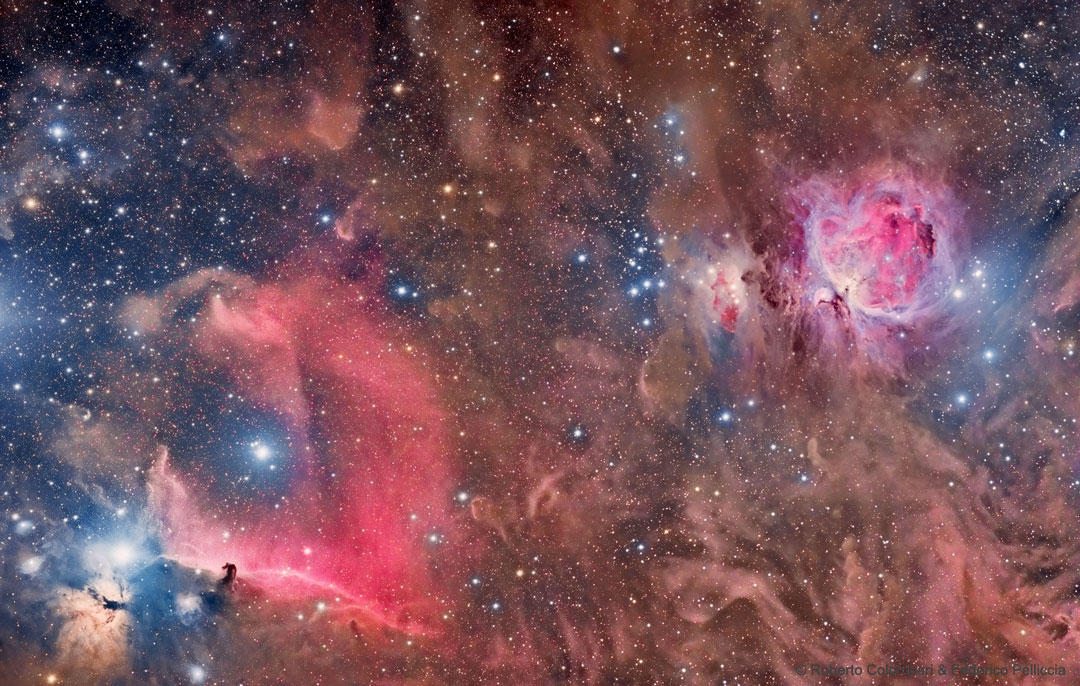Blog
The dark Horsehead Nebula and the glowing Orion Nebula are contrasting cosmic vistas. Adrift 1,500 light-years away in one of the night sky’s most recognizable constellations, they appear in opposite corners of the above stunning mosaic. The familiar Horsehead nebula appears as a dark cloud, a small silhouette notched against the long red glow at the lower left. Alnitak is the easternmost star in Orion’s belt and is seen as the brightest star to the left of the Horsehead. Below Alnitak is the Flame Nebula, with clouds of bright emission and dramatic dark dust lanes. The magnificent emission region, the Orion Nebula (aka M42), lies at the upper right. Immediately to its left is a prominent reflection nebula sometimes called the Running Man. Pervasive tendrils of glowing hydrogen gas are easily traced throughout the region.

Dennis Milton Chambers (born May 9, 1959) is an American drummer. He was inducted into the Modern Drummer Hall of Fame in 2001.
Chambers was born on May 9, 1959. He began drumming at the age of four years, and was gigging in Baltimore-area nightclubs by the age of six. He was recruited in 1981 by the Sugar Hill Label to be their “house drummer.” Chambers played on many Sugar Hill releases — sounds like Keith LeBlanc [not Chambers], who was the Original Sugar Hill Rhythm Section drummer [“White Lines,” “The Message,” “8th Wonder,” and so on], with Skip McDonald (guitar) and Doug Wimbish (bass)]. Contrary to popular belief he did not play on “Rapper’s Delight” which was revealed in a recent interview on Drumeo.com on 6/8/2017.
In an interview by Bonedo in 2011, Chambers was asked who some of his influences and favorite drummers were and he mentioned Clyde Stubblefield, Al Jackson Jr., Steve Gadd, Vinnie Colaiuta, Gary Husband, Jack Dejohnette, Billy Cobham, Buddy Rich, Elvin Jones, Roy Haynes, and Tony Williams. In 1978 (at 18 years old) he joined Parliament/Funkadelic, and stayed with them until 1985. In 1986 he joined the John Scofield band. Since then he has played with most of the major figures in jazz fusion music.
He has recorded and performed with Tommy Coster, John Scofield, George Duke, Victor Wooten, Brecker Brothers, Santana, Parliament/Funkadelic, John McLaughlin, Niacin, Mike Stern, CAB, Greg Howe, and many others.
https://www.youtube.com/watch?v=PuVK9jwBRBU
more...
Nole Floyd “Nokie” Edwards (May 9, 1935 – March 12, 2018) was an American musician and member of the Rock and Roll Hall of Fame. He was primarily a guitarist, best known for his work with The Ventures, and was known in Japan as the ‘King of Guitars’. Edwards was also an actor, who appeared briefly on Deadwood, an American Western drama television series.
Edwards was born in Lahoma, Oklahoma, the son of Elbert Edwards and Nannie Mae Quinton Edwards, an original enrollee of the Western Cherokee. Edwards came from a family of accomplished musicians, so that by age five he began playing a variety of string instruments, including the steel guitar, banjo, mandolin, violin, and bass. His family relocated from Oklahoma to Puyallup, Washington.
During Edwards’ late teen years he joined the United States Army Reserve. After traveling to Texas and California for training, he returned home and began playing regularly for pay in numerous country bands in the area.
more...Aaron Corthen, better known as A.C. Reed (May 9, 1926 – February 24, 2004)[1] was an American blues saxophonist, closely associated with the Chicago blues scene from the 1940s into the 2000s.
Reed was born in Wardell, Missouri, and grew up in southern Illinois. He took his stage name from his friend Jimmy Reed. He moved to Chicagoduring World War II, playing with Earl Hooker and Willie Mabon in the 1940s. He toured with Dennis “Long Man” Binder in 1956, and worked extensively as a sideman for Mel London‘s blues record labels Chief/Profile/Age in the 1960s, with Lillian Offitt and Ricky Allen, among others. He had a regionally popular single in 1961, “This Little Voice” (Age 29101), and cut several more singles over the course of the decade with Age, USA, Cool, and Nike Records.
more...Acclaimed sitar player and Professor Prateek Chaudhuri passed away due to Covid-19 complications on Thursday, May 6, 2021. His father, the celebrated sitar master Devbrata Chaudhuri (Debu Chaudhuri), also died last week due to Covid-19.
Prateek Chaudhuri was born on September 7, 1971. He was an admired sitar player. Prateek trained under his father and belonged to the Senia Gharana of music. He was also a professor at the Department of Music in Delhi University. He is survived by his wife Runa and children Rayana and Adhiraj (also a sitar player).
more...IC 348 is a star-forming region in the constellation Perseuslocated about 315 parsecs from the Sun. It consists of nebulosity and an associated 2-million-year-old cluster of roughly 400 stars within an angular diameter of 20″. The most massive stars in the cluster are the binary star system BD+31°643, which has a combined spectral class of B5. Based upon infrared observations using the Spitzer Space Telescope, about half of the stars in the cluster have a circumstellar disk, of which 60% are thick or primordial disks.
The age of this cluster has allowed three low mass brown dwarfs to be discovered. These objects lose heat as they age, so they are more readily discovered while they are still young.

Keith Jarrett (born May 8, 1945) is an American jazz and classical music pianist and composer.
Jarrett started his career with Art Blakey, moving on to play with Charles Lloyd and Miles Davis. Since the early 1970s he has enjoyed a great deal of success as a group leader and a solo performer in jazz, jazz fusion, and classical music. His improvisations draw from the traditions of jazz and other genres, especially Western classical music, gospel, blues, and ethnic folk music.
In 2003 Jarrett received the Polar Music Prize, the first recipient of both the contemporary and classical musician prizes, and in 2004 he received the Léonie Sonning Music Prize. His album The Köln Concert (1975) became the best-selling piano recording in history.
In 2008 he was inducted into the Down Beat Jazz Hall of Fame in the magazine’s 73rd Annual Readers’ Poll.
Jarrett has been unable to perform since suffering a stroke in February 2018, and a second stroke in May 2018, which left him partially paralyzed and unable to play with his left hand.
Keith Jarrett was born on May 8, 1945, in Allentown, Pennsylvania, United States, to a mother of Slovenian descent. Jarrett’s grandmother was born in Segovci, near Apače in Slovenia, (at the time, this was in the Austria of the Austro-Hungarian Empire). Her own parents probably descended from the Slavic population of Prekmurje, a few miles away in a Hungarian part of the Empire almost totally populated by Slovenes. Jarrett’s father was of mostly German descent.
https://www.youtube.com/watch?v=lBnwDTAoAC8
more...Mahmoud Ahmed (Amharic: ማሀሙድ አህመድ; born May 8 or 18, 1941) is an Ethiopian singer of Gurage ancestry. He gained great popularity in Ethiopia in the 1970s and among the Ethiopian diaspora in the 1980s, before rising to international fame with African music fans in Europe and the Americas.
Born in Addis Ababa, Mercato district, Mahmoud was enthralled with the music he heard on Ethiopian radio from an early age. Having poorly learned in school, he worked shoeshiner before becoming a handyman at the Arizona Club, which was the after hours hangout of Emperor Haile Selassie I‘s Imperial Bodyguard Band. One night in 1962 when the band’s singer didn’t show up, Mahmoud asked to sing a few songs. He soon became part of the band’s regular lineup, where he remained until 1974.
After cutting his first single with Venus Band “Nafqot New Yegodagn” and “Yasdestal” in 1971, Mahmoud continued to record with several bands for the Amha and Kaifa record labels throughout the 1970s The overthrow of Emperor Selassie and the suspension of musical nightlife under the military government created shifts in the Ethiopian music industry—the Imperial Body Guard Band were no more, and Mahmoud continued to make hit records and cassettes with many musicians who remained in the country, including the Dahlak Band, and the Ibex Band. He also began to release solo cassettes, accompanying himself on the krar, guitar or mandolin.
https://www.youtube.com/watch?v=uQzJe6dAf5Q&list=PLl5llMCRZN2lmyE9AhIfSTTm-7Q_eNPlc
more...Mary Lou Williams (born Mary Elfrieda Scruggs; May 8, 1910 – May 28, 1981) was an American jazz pianist, arranger, and composer. She wrote hundreds of compositions and arrangements and recorded more than one hundred records (in 78, 45, and LP versions). Williams wrote and arranged for Duke Ellington and Benny Goodman, and she was friend, mentor, and teacher to Thelonious Monk, Charlie Parker, Miles Davis, Tadd Dameron, Bud Powell, and Dizzy Gillespie.
The second of eleven children, Williams was born in Atlanta, Georgia, and grew up in the East Liberty neighborhood of Pittsburgh, Pennsylvania. A musical prodigy, at the age of three, she taught herself to play the piano. Mary Lou Williams played piano out of necessity at a very young age; her white neighbors were throwing bricks into her house until Williams began playing the piano in their homes. At the age of six, she supported her ten half-brothers and sisters by playing at parties. She began performing publicly at the age of seven when she became known admiringly in Pittsburgh as “The Little Piano Girl”. She became a professional musician at the age of 15, citing Lovie Austin as her greatest influence. She married jazz saxophonist John Williams in November 1926.
more...Robert Leroy Johnson (May 8, 1911 – August 16, 1938) was an American blues guitarist, singer, and songwriter. His landmark recordings in 1936 and 1937 display a combination of singing, guitar skills, and songwriting talent that has influenced later generations of musicians. He is now recognized as a master of the blues, particularly the Delta blues style.
As a traveling performer who played mostly on street corners, in juke joints, and at Saturday night dances, Johnson had little commercial success or public recognition in his lifetime. He participated in only two recording sessions, one in San Antonio in 1936, and one in Dallas in 1937, that produced 29 distinct songs (with 13 surviving alternate takes) recorded by famed Country Music Hall of Fame producer Don Law. These songs, recorded at low fidelity in improvised studios, were the totality of his recorded output. Most were released as 10-inch, 78 rpm singles from 1937–1938, with a few released after his death. Other than these recordings, very little was known of him during his life outside of the small musical circuit in the Mississippi Delta where he spent most of his life; much of his story has been reconstructed after his death by researchers. Johnson’s poorly documented life and death have given rise to much legend. The one most closely associated with his life is that he sold his soul to the devil at a local crossroads to achieve musical success.
His music had a small, but influential, following during his life and in the two decades after his death. In late 1938 John Hammond sought him out for a concert at Carnegie Hall, From Spirituals to Swing, only to discover that Johnson had died. Brunswick Records, which owned the original recordings, was bought by Columbia Records, where Hammond was employed. Musicologist Alan Lomax went to Mississippi in 1941 to record Johnson, also not knowing of his death. Law, who by then worked for Columbia Records, assembled a collection of Johnson’s recordings titled King of the Delta Blues Singers that was released by Columbia in 1961. It is widely credited with finally bringing Johnson’s work to a wider audience. The album would become influential, especially on the nascent British blues movement; Eric Clapton has called Johnson “the most important blues singer that ever lived.”[1] Musicians such as Bob Dylan, Keith Richards, and Robert Plant have cited both Johnson’s lyrics and musicianship as key influences on their own work. Many of Johnson’s songs have been covered over the years, becoming hits for other artists, and his guitar licks and lyrics have been borrowed by many later musicians.
Renewed interest in Johnson’s work and life led to a burst of scholarship starting in the 1960s. Much of what is known about him was reconstructed by researchers such as Gayle Dean Wardlow and Bruce Conforth, especially in their 2019 award-winning biography[2] of Johnson: Up Jumped the Devil: The Real Life of Robert Johnson (Chicago Review Press). Two films, the 1991 documentary The Search for Robert Johnson by John Hammond Jr., and a 1997 documentary, Can’t You Hear the Wind Howl, the Life and Music of Robert Johnson, which included reconstructed scenes with Keb’ Mo’ as Johnson, were attempts to document his life, and demonstrated the difficulties arising from the scant historical record and conflicting oral accounts. Over the years, the significance of Johnson and his music has been recognized by numerous organizations and publications, including the Rock and Roll, Grammy, and Blues Halls of Fame; and the National Recording Preservation Board.
Johnson died on August 16, 1938, at the age of 27, near Greenwood, Mississippi, of unknown causes. His death was not reported publicly; he merely disappeared from the historical record and it was not until almost 30 years later, when Gayle Dean Wardlow, a Mississippi-based musicologist researching Johnson’s life, found his death certificate, which listed only the date and location, with no official cause of death. No formal autopsy was done, as a dead black man found by the side of the road near a farm, a pro forma examination was done to file the death certificate, and no immediate cause of death was determined. It is likely he had congenital syphilis and it was suspected later by medical professionals that may have been a contributing factor in his death. However, 30 years of local legend and oral tradition had, like the rest of his life story, built a legend which has filled in gaps in the scant historical record.
more...mick performing Roots versions of the Stones, the Animals, Buffalo Springfield and the Specials

Messier 78 or M 78, also known as NGC 2068, is a reflection nebula in the constellation Orion. It was discovered by Pierre Méchain in 1780 and included by Charles Messier in his catalog of comet-like objects that same year.
M78 is the brightest diffuse reflection nebula of a group of nebulae that includes NGC 2064, NGC 2067 and NGC 2071. This group belongs to the Orion B molecular cloud complex and is about 1,350 light-years distant from Earth. M78 is easily found in small telescopes as a hazy patch and involves two stars of 10th and 11th magnitude. These two B-type stars, HD 38563 A and HD 38563 B, are responsible for making the cloud of dust in M78 visible by reflecting their light.

Jimmy Lee Ruffin (May 7, 1936 – November 17, 2014) was an American soul singer, and elder brother of David Ruffin of the Temptations. He had several hit records between the 1960s and 1980s, the most successful being the Top 10 hits “What Becomes of the Brokenhearted” and “Hold On (To My Love)“.
Jimmy Ruffin was born in 1936 in Collinsville, Mississippi, to Eli, a sharecropper, and Ophelia Ruffin. He was approaching his fifth birthday when his younger brother David was born. As children, the brothers began singing with a gospel group, the Dixie Nightingales.
In 1961, Jimmy became a singer as part of the Motown stable, mostly on sessions but also recording singles for its subsidiary Miracle label, but was then drafted for national service. After leaving the Army in 1964, he returned to Motown, where he was offered the opportunity to join the Temptations to replace Elbridge Bryant. However, after hearing his brother David, they hired him for the job instead so Jimmy decided to resume his solo career. Ruffin recorded for Motown’s subsidiary Soul label, but with little success.
more...Admirl Amos Easton (May 7, 1905 – June 8, 1968), better known by the stage name Bumble Bee Slim, was an American Piedmont blues singer and guitarist.
Easton was born in Brunswick, Georgia, United States. Several original sources confirm that he spelled his first name “Admirl”. Around 1920 he joined the Ringling Brothers circus. He then returned to Georgia and was briefly married before heading north on a freight train to Indianapolis, where he settled in 1928. There he met and was influenced by the pianist Leroy Carr and the guitarist Scrapper Blackwell.
more...Pyotr Ilyich Tchaikovsky (/tʃaɪˈkɒfski/ chy-KOF-skee; Russian: Пётр Ильи́ч Чайко́вский, IPA: [pʲɵtr ɨˈlʲjitɕ tɕɪjˈkofskʲɪj]; 7 May 1840 – 6 November 1893) was a Russian composer of the Romantic period. He was the first Russian composer whose music would make a lasting impression internationally. He was honored in 1884 by Tsar Alexander III and awarded a lifetime pension.
Although musically precocious, Tchaikovsky was educated for a career as a civil servant. There was scant opportunity for a musical career in Russia at the time and no system of public music education. When an opportunity for such an education arose, he entered the nascent Saint Petersburg Conservatory, from which he graduated in 1865. The formal Western-oriented teaching that he received there set him apart from composers of the contemporary nationalist movement embodied by the Russian composers of The Five with whom his professional relationship was mixed.
Tchaikovsky’s training set him on a path to reconcile what he had learned with the native musical practices to which he had been exposed from childhood. From that reconciliation, he forged a personal but unmistakably Russian style. The principles that governed melody, harmony and other fundamentals of Russian music ran completely counter to those that governed Western European music, which seemed to defeat the potential for using Russian music in large-scale Western composition or for forming a composite style, and it caused personal antipathies that dented Tchaikovsky’s self-confidence. Russian culture exhibited a split personality, with its native and adopted elements having drifted apart increasingly since the time of Peter the Great. That resulted in uncertainty among the intelligentsia about the country’s national identity, an ambiguity mirrored in Tchaikovsky’s career.
Despite his many popular successes, Tchaikovsky’s life was punctuated by personal crises and depression. Contributory factors included his early separation from his mother for boarding school followed by his mother’s early death; the death of his close friend and colleague Nikolai Rubinstein; and the collapse of the one enduring relationship of his adult life, his 13-year association with the wealthy widow Nadezhda von Meck, who was his patroneven though they never actually met each other. His homosexuality, which he kept private, has traditionally also been considered a major factor though some musicologists now downplay its importance. Tchaikovsky’s sudden death at the age of 53 is generally ascribed to cholera, but there is an ongoing debate as to whether cholera was indeed the cause of his death.
more...Nexhmije Pagarusha [neˈd͡ʒmijɛ pagaˈɾuʃa]; 7 May 1933 – 7 February 2020) was an Albanian singer and actress from Republic of Kosovo, often referred to as the queen of Kosovan music. Pagarusha gained acclaim as a recording artist in Kosova and neighbouring countries for her distinct soprano vocal range, which she displayed performing various Kosovan folk songs during her career, which spanned 36 years, from 1948, in her debut in Radio Prishtina, to 1984, in her final concert in Sarajevo. Her music style was not limited just to Albanian music, as she performed rock, pop, funk, opera/classical, and many more. Nexhmije Pagarusha was born in the small village of Pagarusha, near the town of Mališevo, Vardar Banovina, Kingdom of Yugoslavia (present-day Kosovo). She finished primary school in Mališevo and then went to Belgrade, where she attended a music school for three years, in the solo cantosection. She began her music career as a singer for Radio Pristina in 1948.
more...More Posts
- The Cosmos with NGC 7000
- Jimmy Heath Day
- Earl Palmer Day
- Eddie Lang Day
- World Music with Corvus Corax
- Daily Roots with the Abyssinians
- Lisa Gutkin Performance Tech 10-24-18
- The Cosmos with NGC 772
- Joe Watkins Day
- Jimmy Dawkins Day
- Sonny Terry Day
- World Music with Mahala Rai Banda
- Daily Roots with Pablo Moses
- The Cosmos with NGC 4676
- Gary McFarland Day
- Frank Hewitt Day
- Sonny Criss Day
- World Music with Hassan Erraji
- Daily Roots with Clinton Fearon
- The Cosmos with ESO 97-G13
